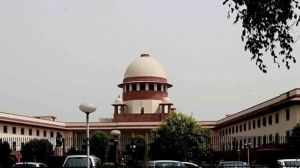Delhi floods each monsoon — here’s what’s causing it
PWD Minister Parvesh Sahib Singh said the government's efforts had ensured that out of the 45 major waterlogging sites, 35 areas saw no disruptions on Thursday. He, however, acknowledged that there were several problem areas that needed to be fixed.
 Heavy rain lashed the National Capital for nearly eight hours on Thursday. (Renuka Puri)
Heavy rain lashed the National Capital for nearly eight hours on Thursday. (Renuka Puri)Fallen trees, collapsed buildings and overflowing roads – Delhi was a picture of mayhem for much of Thursday morning as heavy rain lashed the city for nearly eight hours.
Waterlogging complaints poured in from Dhaula Kuan, ITO, Chhatarpur, Saket and Lajpat Nagar, among others. In all, civic agencies, including Municipal Corporation of Delhi, New Delhi Municipal Council and the Public Works Department (PWD) received around 100 waterlogging complaints from across the city.
PWD Minister Parvesh Sahib Singh said the government’s efforts had ensured that out of the 45 major waterlogging sites, 35 areas saw no disruptions on Thursday. He, however, acknowledged that there were several problem areas that needed to be fixed.
“Delhi witnessed more than average rainfall today, yet our PWD teams worked in a mission-mode to ensure traffic movement across the city was restored quickly. On several key stretches — including AIIMS Flyover, South Extension, New Rohtak Road (Anand Parbat), Moolchand underpass, GGR–PDR stretch, Sanjay T-Point, NSG red light, and Azad Market railway underpass — waterlogging was completely cleared within 2-3 hours, ensuring minimal disruption for commuters,” he said.
“However, certain locations faced site-specific challenges. These include Punjabi Bagh underpass, which was waterlogged due to a broken drain currently under repair; Adarsh Nagar Metro to Jahangirpuri stretch – a low-lying area; the ITO complex, which was affected because heavy rainfall combined with inflow from MCD drains into PWD drains exceeded carrying capacity,” he added.
For Delhi, which has witnessed a wetter than usual monsoon, however, waterlogging has been a perennial issue.
It was its inability to fix civic issues such as waterlogging and garbage disposal that played a significant role in the ouster of the AAP in February, after being in power in the Capital for 11 years. The BJP government has been in power in Delhi for six months.
Delhi received 92.5 mm of rain at Safdarjung in 24 hours, the highest received in a single day this year so far.
While not common, this is not unprecedented either. Last year, Delhi received 107.6 mm of rain in 24 hours in August. In 2021, 138.8 mm was received in a day.
So, why is Delhi still ill-equipped to handle rain?
Delhi’s drainage network is not only fragmented but also old. Many of its major drains date back to the colonial era, designed for a fraction of today’s population. Delhi’s last comprehensive drainage master plan was drawn up in 1976 when the city’s population was just 60 lakh. Today, that number has swelled to over 2.6 crore.
A combination of old and crumbling drainage infrastructure, encroachment on traditional drainage routes as well as poor desilting lead to poor drainage.
The desilting targets set by civic bodies do not pertain to the percentage of the drainage network being cleared of silt, but to targets set pre-monsoon in terms of the amount of silt to be extracted. This simply means that the agencies set a target for removal of silt each year and 100% desilting is marked when those targets are achieved.







